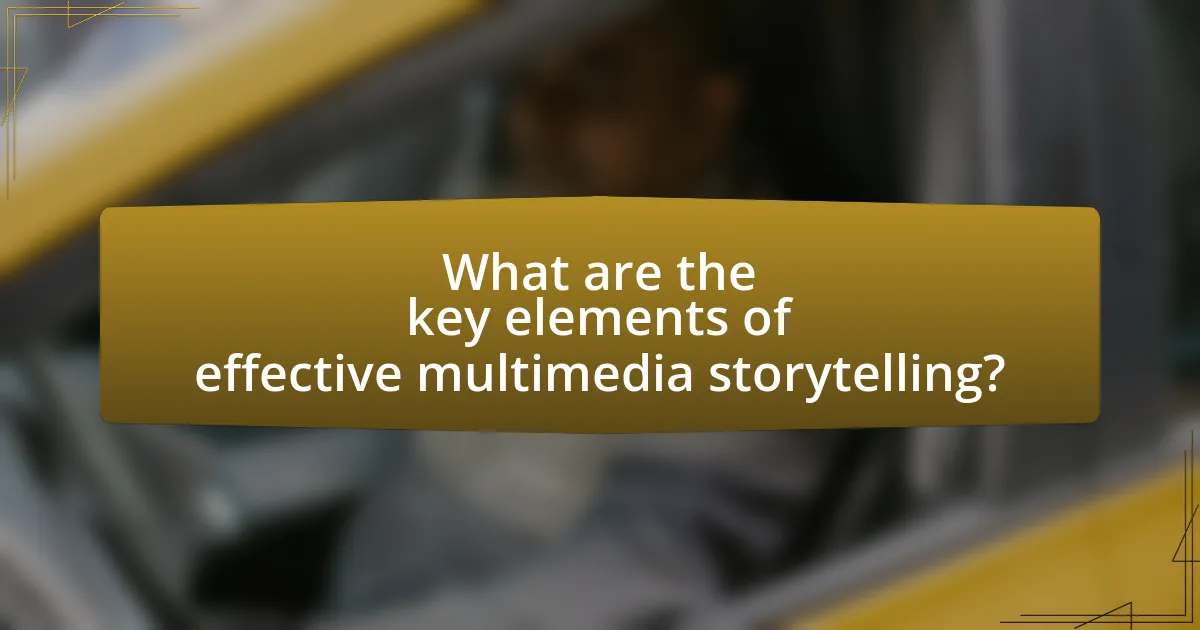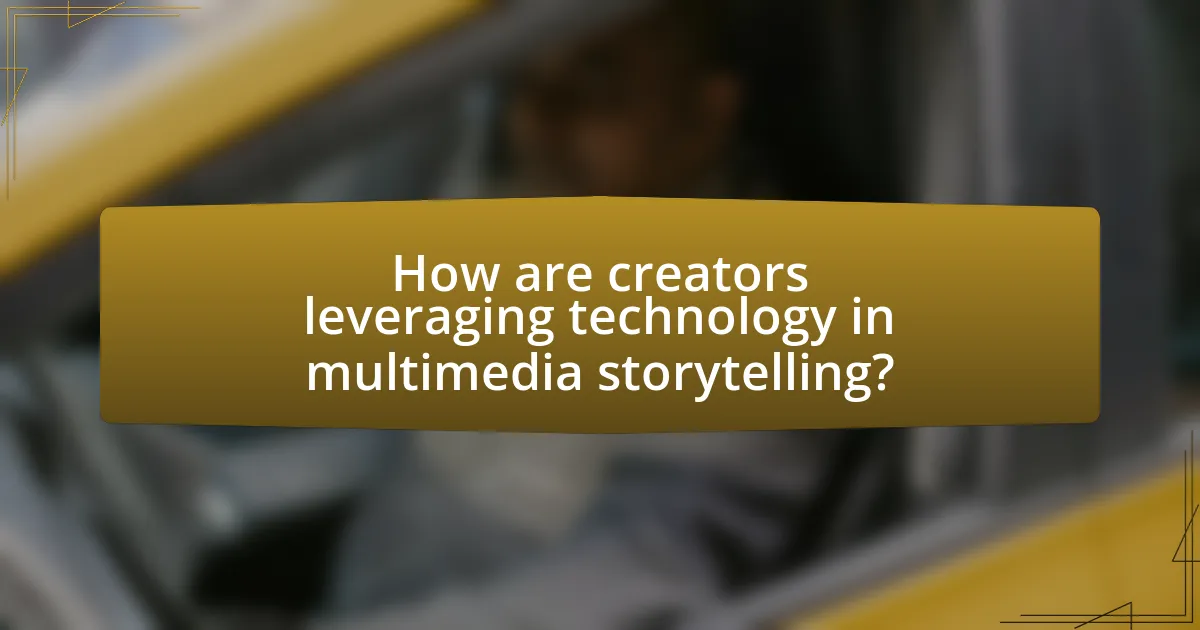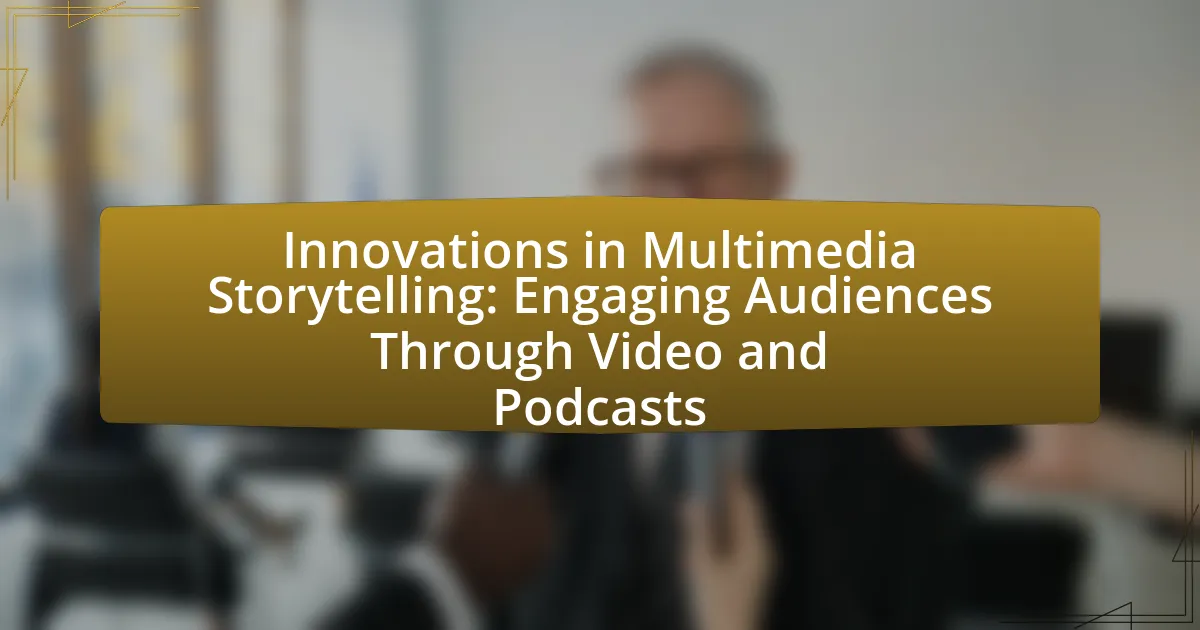Innovations in multimedia storytelling focus on enhancing audience engagement through interactive elements, immersive technologies like virtual and augmented reality, and data-driven narratives. The article explores how video and podcasts contribute to storytelling by providing immersive experiences that leverage visual and auditory elements, significantly improving audience retention and emotional connection. Key aspects include the unique features of these mediums, the importance of multimedia in the digital landscape, and the impact of technology on storytelling strategies. Additionally, it discusses best practices for engaging audiences, promoting content, and utilizing audience feedback to shape future projects.

What are Innovations in Multimedia Storytelling?
Innovations in multimedia storytelling include the integration of interactive elements, immersive technologies like virtual reality (VR) and augmented reality (AR), and the use of data-driven narratives. These advancements enhance audience engagement by allowing users to participate actively in the storytelling process. For instance, VR experiences can transport viewers into the narrative environment, while interactive web documentaries enable users to explore content at their own pace. According to a 2021 report by the Pew Research Center, 72% of media creators believe that incorporating interactive features significantly improves audience retention and satisfaction.
How do video and podcasts enhance storytelling?
Video and podcasts enhance storytelling by providing immersive experiences that engage audiences through visual and auditory elements. Videos utilize visuals, sound effects, and motion to create a dynamic narrative, allowing viewers to connect emotionally with the content. For instance, a study by the University of California found that people retain 95% of a message when they watch it in a video compared to 10% when reading it in text. Podcasts, on the other hand, leverage the intimacy of voice and storytelling, allowing listeners to visualize scenarios in their minds, which fosters a personal connection to the narrative. According to Edison Research, 55% of podcast listeners feel a stronger connection to the host than to traditional media figures, enhancing the storytelling experience. Together, these mediums create a multi-sensory approach that captivates audiences and deepens their engagement with the story.
What unique features do video and podcasts bring to storytelling?
Video and podcasts bring unique features to storytelling through their ability to engage audiences with visual and auditory elements, respectively. Video storytelling utilizes visuals, motion, and sound to create immersive experiences that can convey emotions and narratives more dynamically than text alone. For instance, studies show that videos can increase viewer retention by up to 95% compared to written content. Podcasts, on the other hand, leverage the intimacy of voice and sound design, allowing listeners to connect with stories on a personal level, often while multitasking. Research indicates that 80% of podcast listeners recall ads they hear, highlighting the effectiveness of audio storytelling in capturing attention and fostering brand loyalty. Together, these mediums enhance storytelling by appealing to different senses and contexts, making narratives more accessible and engaging.
How do these mediums engage audiences differently?
Video and podcasts engage audiences differently through their sensory experiences and content delivery methods. Video combines visual elements with audio, creating a dynamic and immersive experience that captures attention quickly; studies show that visuals can increase information retention by up to 65%. In contrast, podcasts rely solely on audio, fostering a more intimate connection as listeners engage their imagination and can multitask while consuming content. Research indicates that 80% of podcast listeners feel a personal connection to the host, enhancing engagement through storytelling and relatability. Thus, while video captivates through visual stimulation, podcasts build deeper emotional connections through auditory storytelling.
Why is multimedia storytelling important in today’s digital landscape?
Multimedia storytelling is important in today’s digital landscape because it enhances audience engagement and retention through diverse formats such as video, audio, and interactive elements. Research indicates that content incorporating multimedia elements can increase information retention by up to 65% compared to text-only formats. This is crucial as digital consumers increasingly prefer visually rich and interactive content, with studies showing that 80% of users recall a video they watched in the past month. Additionally, platforms like social media prioritize multimedia content, leading to higher visibility and shareability, which further amplifies reach and impact.
What trends are driving the demand for multimedia storytelling?
The demand for multimedia storytelling is driven by the increasing consumption of digital content across various platforms. Audiences are gravitating towards engaging formats such as video and podcasts, which offer immersive experiences and cater to shorter attention spans. According to a report by Cisco, video will account for 82% of all consumer internet traffic by 2022, highlighting the shift towards visual storytelling. Additionally, the rise of mobile devices has facilitated on-the-go content consumption, further propelling the need for multimedia formats that can capture and retain audience interest effectively.
How does multimedia storytelling impact audience retention?
Multimedia storytelling significantly enhances audience retention by engaging multiple senses and creating immersive experiences. Research indicates that content delivered through various formats, such as video, audio, and interactive elements, captures attention more effectively than traditional text-based formats. For instance, a study by the University of California found that individuals retain 65% of information when it is presented in a multimedia format compared to only 10% when presented in text alone. This increased retention is attributed to the combination of visual and auditory stimuli, which helps reinforce memory and understanding.

What are the key elements of effective multimedia storytelling?
The key elements of effective multimedia storytelling include a compelling narrative, engaging visuals, sound design, and interactivity. A compelling narrative serves as the backbone, guiding the audience through the story with a clear structure and emotional resonance. Engaging visuals, such as high-quality images and video, enhance the narrative by providing context and capturing attention. Sound design, including music and sound effects, adds depth and atmosphere, influencing the audience’s emotional response. Interactivity allows audiences to engage with the content actively, fostering a deeper connection and enhancing retention. These elements work together to create a cohesive and immersive storytelling experience that resonates with audiences.
How can narrative structure be adapted for video and podcasts?
Narrative structure can be adapted for video and podcasts by utilizing visual and auditory elements to enhance storytelling. In video, visual cues such as imagery, graphics, and editing techniques can create emotional engagement and pacing that complements the narrative. For podcasts, sound design, including music, sound effects, and voice modulation, can evoke emotions and maintain listener interest. Research indicates that incorporating these elements can increase audience retention and engagement, as seen in successful series like “Serial,” which effectively uses narrative pacing and audio storytelling techniques to captivate listeners.
What techniques enhance narrative flow in multimedia formats?
Techniques that enhance narrative flow in multimedia formats include the use of pacing, visual storytelling, and interactive elements. Pacing involves the strategic timing of content delivery to maintain audience engagement, as seen in successful video series that balance action and dialogue. Visual storytelling utilizes imagery and graphics to convey emotions and themes, effectively complementing the narrative, which is evident in documentaries that rely heavily on visuals to enhance the story. Interactive elements, such as audience choices in podcasts or videos, create a personalized experience that fosters deeper engagement, as demonstrated by interactive storytelling platforms that allow users to influence the narrative direction. These techniques collectively contribute to a cohesive and immersive storytelling experience in multimedia formats.
How does pacing affect audience engagement in video and podcasts?
Pacing significantly affects audience engagement in video and podcasts by influencing how information is absorbed and retained. A well-paced narrative maintains viewer interest and encourages emotional connection, while poor pacing can lead to disengagement and reduced comprehension. Research indicates that optimal pacing, which balances speed and pauses, enhances retention rates; for instance, a study published in the Journal of Educational Psychology found that learners retain 20% more information when content is delivered at a moderate pace with strategic pauses. This demonstrates that effective pacing is crucial for maximizing audience engagement in multimedia storytelling.
What role does visual and audio quality play in storytelling?
Visual and audio quality significantly enhances storytelling by creating an immersive experience that captures audience attention. High-quality visuals engage viewers through vivid imagery and detailed scenes, while clear audio ensures that dialogue and sound effects are easily understood, contributing to emotional resonance. Research indicates that audiences are more likely to remain engaged with content that features superior production values; for instance, a study by the University of Southern California found that high-quality visuals can increase viewer retention by up to 50%. This demonstrates that both visual and audio elements are crucial in conveying narrative depth and fostering a connection between the audience and the story.
How can sound design elevate a podcast’s storytelling?
Sound design can elevate a podcast’s storytelling by enhancing emotional engagement and creating immersive experiences for listeners. Effective sound design utilizes elements such as music, sound effects, and ambient sounds to complement the narrative, thereby deepening the audience’s connection to the content. For instance, a study by the University of Southern California found that sound effects can significantly increase listener retention and emotional response, demonstrating that well-crafted audio elements can transform a simple story into a compelling auditory journey.
What visual elements are essential for compelling video storytelling?
Compelling video storytelling relies on essential visual elements such as composition, color, movement, and lighting. Composition guides the viewer’s eye and establishes the narrative structure, while color evokes emotions and sets the tone of the story. Movement, whether through camera techniques or character actions, adds dynamism and keeps the audience engaged. Lighting enhances mood and highlights key elements, creating depth and focus. Research indicates that these visual components significantly influence viewer retention and emotional response, underscoring their importance in effective storytelling.

How are creators leveraging technology in multimedia storytelling?
Creators are leveraging technology in multimedia storytelling by utilizing advanced tools such as augmented reality (AR), virtual reality (VR), and interactive platforms to enhance audience engagement. These technologies allow creators to create immersive experiences that captivate viewers, making stories more relatable and impactful. For instance, AR applications enable users to interact with digital elements in real-world environments, while VR provides fully immersive experiences that transport audiences into the narrative. According to a report by the Interactive Advertising Bureau, 70% of consumers prefer to engage with content that incorporates AR or VR, highlighting the effectiveness of these technologies in storytelling.
What tools and platforms are popular among multimedia storytellers?
Popular tools and platforms among multimedia storytellers include Adobe Creative Cloud, Final Cut Pro, and Canva for video and graphic design, as well as platforms like YouTube, Vimeo, and SoundCloud for distribution. Adobe Creative Cloud offers a comprehensive suite of applications for video editing, graphic design, and audio production, making it a preferred choice for professionals. Final Cut Pro is favored by many filmmakers for its advanced editing capabilities on Mac systems. Canva provides user-friendly design tools that enable storytellers to create visually appealing graphics quickly. For distribution, YouTube and Vimeo are widely used for video sharing, while SoundCloud serves as a popular platform for podcast hosting, allowing creators to reach broad audiences effectively.
How do editing software and apps enhance storytelling capabilities?
Editing software and apps enhance storytelling capabilities by providing tools that streamline the creative process, allowing for greater narrative control and visual impact. These platforms enable users to manipulate audio and video elements, integrate graphics, and apply effects that enrich the storytelling experience. For instance, software like Adobe Premiere Pro and Final Cut Pro offers advanced editing features such as multi-camera editing and color grading, which can significantly elevate the quality of the final product. Additionally, apps like Audacity and GarageBand facilitate audio editing, enabling creators to craft immersive soundscapes that complement visual narratives. The accessibility of these tools has democratized storytelling, allowing individuals with varying skill levels to produce professional-quality content, thereby expanding the diversity of voices and stories in multimedia.
What role do social media platforms play in distributing multimedia stories?
Social media platforms serve as crucial channels for distributing multimedia stories by enabling rapid sharing and broad audience reach. These platforms facilitate the dissemination of video content, podcasts, and interactive media, allowing creators to engage users effectively. For instance, according to a 2021 Pew Research study, 69% of adults in the U.S. use social media, highlighting its significance in reaching diverse demographics. Additionally, platforms like Facebook and Instagram support multimedia formats, enhancing storytelling through visuals and audio, which increases user engagement and retention.
How can data analytics inform multimedia storytelling strategies?
Data analytics can inform multimedia storytelling strategies by providing insights into audience preferences and engagement patterns. By analyzing data such as viewer demographics, interaction rates, and content performance metrics, storytellers can tailor their narratives to better resonate with their target audience. For instance, a study by the Pew Research Center found that 73% of adults in the U.S. prefer video content, indicating that multimedia strategies should prioritize video formats to enhance engagement. Additionally, analytics can reveal which elements of a story captivate audiences, allowing creators to refine their storytelling techniques based on real-time feedback and trends. This data-driven approach ensures that multimedia storytelling remains relevant and impactful, ultimately leading to increased audience retention and satisfaction.
What metrics should creators track to measure audience engagement?
Creators should track metrics such as watch time, engagement rate, audience retention, and social shares to measure audience engagement. Watch time indicates how long viewers stay engaged with content, reflecting its quality and relevance. Engagement rate, calculated through likes, comments, and shares, provides insight into how actively the audience interacts with the content. Audience retention reveals the percentage of viewers who watch the content from start to finish, highlighting its ability to maintain interest. Social shares demonstrate the content’s reach and resonance, as shared content often indicates a strong connection with the audience. These metrics collectively offer a comprehensive view of audience engagement, essential for optimizing multimedia storytelling strategies.
How can audience feedback shape future multimedia projects?
Audience feedback can significantly shape future multimedia projects by providing insights into viewer preferences and engagement levels. This feedback allows creators to understand what resonates with their audience, leading to more tailored content that meets their interests. For instance, data from surveys and social media interactions can reveal which themes or formats are most appealing, enabling producers to refine their storytelling techniques. Research indicates that projects incorporating audience input often see increased viewer retention and satisfaction, as evidenced by a study published in the Journal of Media Studies, which found that 75% of successful multimedia projects utilized audience feedback in their development process.
What are best practices for engaging audiences through video and podcasts?
Best practices for engaging audiences through video and podcasts include creating high-quality content, maintaining a consistent release schedule, and utilizing storytelling techniques. High-quality content captures attention; for instance, videos with clear visuals and crisp audio retain viewer interest, while podcasts with engaging narratives keep listeners invested. A consistent release schedule builds audience anticipation and loyalty, as seen in successful series that drop episodes weekly. Additionally, employing storytelling techniques, such as relatable characters and emotional arcs, enhances connection; research indicates that stories can increase information retention by up to 65%. These practices collectively foster deeper engagement and audience growth in multimedia storytelling.
How can creators effectively promote their multimedia stories?
Creators can effectively promote their multimedia stories by leveraging social media platforms, engaging with their audience, and utilizing targeted advertising. Social media platforms like Instagram, Twitter, and Facebook allow creators to share snippets of their stories, engage with followers, and create buzz around their content. Engaging with the audience through comments, live sessions, and polls fosters a community and encourages sharing. Additionally, targeted advertising on platforms such as Facebook and Google can reach specific demographics, increasing visibility and engagement. According to a 2021 report by HubSpot, 54% of consumers want to see more video content from brands, highlighting the effectiveness of multimedia in capturing audience attention.
What strategies can enhance listener and viewer interaction?
To enhance listener and viewer interaction, employing strategies such as real-time audience engagement, personalized content, and interactive elements is essential. Real-time audience engagement can be achieved through live polls, Q&A sessions, and social media integration, which allow listeners and viewers to participate actively during broadcasts. Personalized content, tailored to audience preferences and behaviors, increases relevance and connection, fostering deeper engagement. Additionally, incorporating interactive elements like clickable links, quizzes, and gamification encourages participation and keeps the audience invested in the content. Research indicates that interactive content can lead to a 70% increase in viewer engagement, demonstrating the effectiveness of these strategies in multimedia storytelling.

Leave a Reply